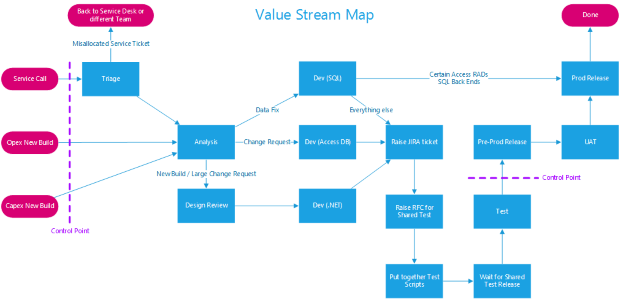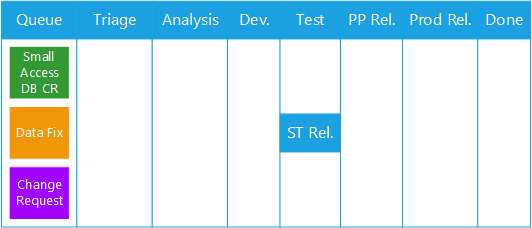Share this
Introducing Agile in Government - part 2: Implementing Kanban
by Ray Cooke on 03 June 2016
In my previous post Introducing Agile in Government – part 1: Assessing current state, I introduced that I’ve been helping a government development team improve their capability. In that post I spoke about how I assessed the team’s current state and what I found. In this article I continue discussing the experiences during the work with a focus on implementing Kanban within the team.
First steps - choosing the Kanban methodology
So having assessed the current state, we concluded that the problems that needed the most urgent attention were those affecting quality and predictability. However, to be able to address these with any confidence the team needed to be able see what their quality and predictability were like in the first place, which meant some kind of work tracking and reporting mechanism.
I chose Kanban as a methodology for a number of reasons but initially and primarily because it required very little change to their existing work processes yet gave them a mechanism to start highlighting problems with their process as well as numerical means to judge their own performance.
Value Stream Mapping
My first practical step was putting together a Value Stream Map (VSM) of the work that the team did. Preparing the VSM required more discussion and iteration with the team over a diagram, which ended being relatively complex because of the variety of the work that the team did. Here is the VSM that we came up with:

View larger Value Stream Map image.
For those of you that are already familiar with VSM you'll notice that some of the key components (such as value times and waste) are not on this. That's because collectively we had no real idea of what these values were and therefore where to concentrate efforts. It was precisely this problem I was hoping to solve first with the introduction of Kanban. The workflow was sufficient to put together a visual board and a tracking system. There are also a couple of other additions or departures on this example when compared with a typical VSM, which I personally found useful:
- The inclusion of cut-offs (labelled "control point") defining the parts of the process over which we believed the team had control; effectively the boundaries of the team's sphere of influence at the time.
- The defining of the VSM more like a flow diagram, as this was easier for the team to understand and disagree with, leading to the surfacing of flows and other work that might otherwise have been lost.
Getting from Value Stream Map to Kanban board
I had originally feared that the team wouldn't like having their work up on a public visual board but thankfully they were open to the idea. I'd like to believe that this was because I'd built sufficient desire at that point and some subtle suggestions about how the board would also show problems elsewhere in the department was enough to swing the vote, but I'll never know for sure!
Of course the physical board isn't necessary if an electronic equivalent exists but I think there are a number of advantages to the former given the increased transparency and the tactile nature of this approach. The physical board we started with looked like the following:

Some aspects worth pointing out:
- There are a few different types of work that go through the team and these were identified separately with different colour post-it notes and different service classes.
- Despite there being different flows in the VSM we opted for a single representation of flow on this board. This was something we actually changed at a later date.
- Some parts of the existing workflow, around Test for example, were circular and dependent upon change request lead-times for the test environment. There was no inherently obvious way to model this, which actually highlighted a problem in itself around context switching that I'll get to in a later blog post. We started by showing this as a linear flow but this didn't work very well for the team and didn't really represent truth, so we changed the Test column to have two swim lanes which the ticket then iterated between before continuing. A check-list on the card covered off the aspects that needed to be complete before transitioning on from the Test column.
- There were no WIP limits to start off with. This was intentional because of the current state and variety of the work that the team was engaged in. I was hoping to introduce WIP limits pretty soon after getting the board up and running, once the team was used to the board, however, for various reasons which I'll get in to in a later post, it was actually quite a while before this happened. Of all the lessons I learnt while helping this team, this I believe was one of the most significant. Getting WIP limits in sooner rather than later is worth the pain it causes. Without them, unsurprisingly, Kanban as a methodology just doesn't work, despite people's best intentions!
In part 3 of this series Introducing Agile in Government - part 3: Getting the Kanban board right I continue to look at the Kanban board and how I helped the team to get the board right for their needs. Thanks for reading and I'll get this next instalment up shortly.
Ray Cooke is a Lean and Agile business transformation coach, based in Equinox IT’s Wellington, New Zealand office.
Share this
- Agile Development (84)
- Software Development (64)
- Scrum (39)
- Business Analysis (28)
- Agile (27)
- Application Lifecycle Management (26)
- Capability Development (20)
- Requirements (20)
- Solution Architecture (19)
- Lean Software Development (17)
- Digital Disruption (16)
- IT Project (15)
- Project Management (15)
- Coaching (14)
- DevOps (14)
- Equinox IT News (12)
- IT Professional (11)
- Knowledge Sharing (10)
- Strategic Planning (10)
- Agile Transformation (9)
- Digital Transformation (9)
- IT Governance (9)
- International Leaders (9)
- People (9)
- IT Consulting (8)
- AI (7)
- Cloud (7)
- MIT Sloan CISR (7)
- ✨ (7)
- Change Management (6)
- Azure DevOps (5)
- Innovation (5)
- Working from Home (5)
- Business Architecture (4)
- Continuous Integration (4)
- Enterprise Analysis (4)
- FinOps (4)
- Client Briefing Events (3)
- Cloud Value Optimisation (3)
- GitHub (3)
- IT Services (3)
- Business Rules (2)
- Data Visualisation (2)
- Java Development (2)
- Security (2)
- System Performance (2)
- Automation (1)
- Communities of Practice (1)
- Kanban (1)
- Lean Startup (1)
- Microsoft Azure (1)
- Satir Change Model (1)
- Testing (1)
- November 2025 (1)
- August 2025 (3)
- July 2025 (3)
- March 2025 (1)
- December 2024 (1)
- August 2024 (1)
- February 2024 (3)
- January 2024 (1)
- September 2023 (2)
- July 2023 (3)
- August 2022 (4)
- July 2021 (1)
- March 2021 (1)
- February 2021 (1)
- November 2020 (2)
- July 2020 (1)
- June 2020 (2)
- May 2020 (2)
- March 2020 (3)
- August 2019 (1)
- July 2019 (2)
- June 2019 (1)
- April 2019 (2)
- October 2018 (1)
- August 2018 (1)
- July 2018 (1)
- April 2018 (2)
- January 2018 (1)
- September 2017 (1)
- July 2017 (1)
- February 2017 (1)
- January 2017 (1)
- October 2016 (2)
- September 2016 (1)
- August 2016 (4)
- July 2016 (3)
- June 2016 (3)
- May 2016 (4)
- April 2016 (5)
- March 2016 (1)
- February 2016 (1)
- January 2016 (1)
- December 2015 (5)
- November 2015 (11)
- October 2015 (3)
- September 2015 (1)
- August 2015 (1)
- July 2015 (7)
- June 2015 (7)
- April 2015 (1)
- March 2015 (2)
- February 2015 (2)
- December 2014 (3)
- September 2014 (2)
- July 2014 (1)
- June 2014 (2)
- May 2014 (8)
- April 2014 (1)
- March 2014 (2)
- February 2014 (2)
- November 2013 (1)
- October 2013 (2)
- September 2013 (2)
- August 2013 (2)
- May 2013 (1)
- April 2013 (3)
- March 2013 (2)
- February 2013 (1)
- January 2013 (1)
- November 2012 (1)
- October 2012 (1)
- September 2012 (1)
- July 2012 (2)
- June 2012 (1)
- May 2012 (1)
- November 2011 (2)
- August 2011 (2)
- July 2011 (3)
- June 2011 (4)
- April 2011 (2)
- February 2011 (1)
- January 2011 (2)
- December 2010 (1)
- November 2010 (1)
- October 2010 (1)
- February 2010 (1)
- July 2009 (1)
- October 2008 (1)